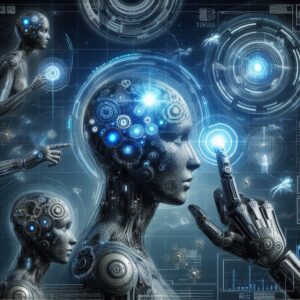In the ever-accelerating realm of technological innovation, the interface between humans and machines stands as a frontier continuously undergoing transformation. From clunky interfaces of the past to the seamless interactions of today, the evolution of human-machine interface (HMI).
The Journey of Human-Machine Interaction:
The trajectory of human-machine interaction has been a story of continuous evolution, marked by groundbreaking advancements that have fundamentally altered the way we interact with technology. Early interfaces relied on keyboards and mouse inputs, offering limited engagement and requiring users to adapt to the machine’s language.
Rise of Intuitive Interfaces: Evolving Frontiers
However, a paradigm shift emerged with the advent of touchscreens, enabling a more intuitive and direct form of interaction. Smartphones and tablets revolutionized the way we communicate, work, and access information.
Voice-Activated Systems
Voice-activated systems, powered by artificial intelligence (AI) and natural language processing, represent another leap forward. Virtual assistants like Siri, Alexa, and Google Assistant have become integral parts of our lives.
Immersive Experiences: AR and VR
The realms of Augmented Reality (AR) and Virtual Reality (VR) have redefined interaction by immersing users in digital environments. These technologies create a bridge between the physical and digital worlds, offering immersive experiences.
Advancements Driving the Evolution:
AI and Machine Learning
The proliferation of AI and machine learning has been a driving force behind the evolution of HMI. Machine learning algorithms enable systems to adapt and learn from user behavior, tailoring interfaces to individual preferences and enhancing user experiences.
Sensor Technology and IoT Integration
Advancements in sensor technology and the integration of the Internet of Things (IoT) have played a pivotal role. Sensors embedded in devices allow for contextual awareness, enabling machines to perceive and respond to their environment, creating more personalized and responsive interfaces.
Brain-Computer Interfaces (BCI)
BCIs represent a frontier where the interface transcends traditional physical inputs. These interfaces establish a direct communication channel between the human brain and machines, holding the promise of revolutionizing accessibility for people with disabilities.
Implications and Future Directions
The ongoing evolution of HMI and interaction holds profound implications across various domains:
Enhanced User Experience
Advancements in HMI lead to more intuitive, personalized, and immersive user experiences across devices and applications, fostering greater user engagement and satisfaction.
Increased Accessibility
Innovations like BCIs hold the potential to break barriers, enabling individuals with disabilities to interact with technology in unprecedented ways, thereby enhancing accessibility and inclusivity.
Transforming Industries: Evolving Frontiers
Industries ranging from healthcare and education to manufacturing and entertainment are witnessing transformative shifts due to enhanced interfaces.
Conclusion: Embracing the Evolving Interface
As technology continues to progress, the interface between humans and machines evolves, striving for greater seamlessness and symbiosis. The convergence of AI, IoT, immersive technologies, and novel interfaces reshapes the way we interact with technology, unlocking possibilities that seemed unimaginable just a few years ago.

The journey of human-machine interface and interaction is one of perpetual evolution, transcending boundaries to create intuitive, seamless, and transformative experiences. Embracing these advancements heralds a future where the interface between humans and technology becomes increasingly natural, intuitive, and integrated into our daily lives.
For more Articles like this, Visit Our Website Here
